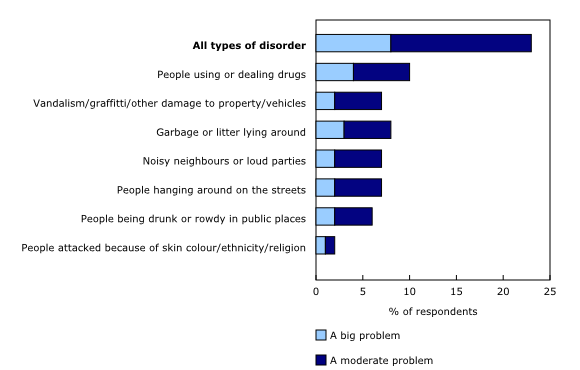Study: Canadians' perceptions of neighbourhood disorder, 2014
Archived Content
Information identified as archived is provided for reference, research or recordkeeping purposes. It is not subject to the Government of Canada Web Standards and has not been altered or updated since it was archived. Please "contact us" to request a format other than those available.
Released: 2016-03-02
Approximately 6.6 million Canadians 15 years of age and over, or about one in four (23%), perceived some kind of disorder in their neighbourhood, according to results from the 2014 General Social Survey (GSS) on Victimization. However, fewer than 1 in 10 (8%) reported that one or more types of disorder were big problems in their neighbourhood.
Types of neighbourhood disorder measured in the GSS on Victimization included: noisy neighbours or loud parties, people hanging around on the streets, garbage or litter lying around, vandalism, graffiti, or other damage to property or vehicles, people being attacked because of their skin colour, ethnicity, or religion, people using or dealing drugs, and people being drunk or rowdy in public places.
Of these, certain types of disorder were more commonly identified as big or moderate problems by Canadians. While 10% of Canadians perceived drug use or drug dealing to be a problem in their neighbourhood, 2% believed that people being attacked because of their skin colour, ethnicity, or religion was a problem.
The overall proportion of Canadians who perceived neighbourhood disorder has decreased slightly over the past decade, down 2 percentage points since 2004 (25% compared with 23%). That said, compared with 2004, Canadians were more likely to state that noisy neighbours or loud parties were an issue in their neighbourhood.
Perceptions of neighbourhood disorder vary across the provinces. In 2014, a higher proportion of residents of Alberta (26%) and Quebec (25%) perceived disorder in their neighbourhoods compared with the national average. In contrast, perceptions of neighbourhood disorder were below the national average in Ontario (22%) and New Brunswick (19%).
In most provinces, perceptions of neighbourhood disorder have remained stable compared with 2004. Newfoundland and Labrador was the lone province where residents were more likely to perceive neighbourhood disorder in 2014 (25%) than 2004 (17%). In both British Columbia and New Brunswick, residents were less likely to perceive neighbourhood disorder compared with a decade ago, while there were no significant changes in any other province.
Both individual and neighbourhood characteristics are associated with perception of disorder
Almost one-third (29%) of Canadians between the ages of 25 to 34 perceived neighbourhood disorder, and perceptions generally decreased with age thereafter. Women were more likely than men to perceive neighbourhood disorder, a difference that was driven by a slightly higher proportion of women who believed people using or dealing drugs was a problem in their neighbourhood. Furthermore, among residents of census metropolitan areas, those who lived in the core were more likely to perceive disorder that those who lived within a census metropolitan area but outside the core.
In addition to individual characteristics, certain neighbourhood characteristics were associated with varying levels of perceived disorder. Canadians who lived in neighbourhoods with higher median household incomes, regardless of their individual income, were less likely to perceive neighbourhood disorder. Additionally, those living in areas with higher proportions of homeowners and lower proportions of residents who had moved in the past five years were less likely to perceive disorder.
When both demographic and neighbourhood characteristics were taken into account, Canadian men over the age of 55, with a household income in the top 25% of Canadian households, and who lived in an area with a high proportion of homeowners were less likely to perceive neighbourhood disorder. In contrast, those who lived in neighbourhoods with comparatively fewer residents over the age of 65 and a higher proportion of low-income families were more likely to perceive neighbourhood disorder.
Note to readers
The public is also invited to chat with an expert on Canadians' perceptions of neighbourhood disorder on Thursday, March 3, 2016, from 12:30 to 1:30 p.m., Eastern Time.
Today, Statistics Canada releases a report on Canadians' perceptions of neighbourhood disorder, based on data from the 2014 General Social Survey on Victimization.
For this report, the target population included all persons 15 years of age and older living in the provinces and excluded full-time residents of institutions.
Products
The article "Canadians' perceptions of neighbourhood disorder, 2014 " is now available as part of Spotlight on Canadians: Results from the General Social Survey (89-652-X) from the Browse by key resource module of our website under Publications.
Contact information
For more information, or to enquire about the concepts, methods or data quality of this release, contact us (toll-free 1-800-263-1136; 514-283-8300; STATCAN.infostats-infostats.STATCAN@canada.ca) or Media Relations (613-951-4636; STATCAN.mediahotline-ligneinfomedias.STATCAN@canada.ca).
- Date modified:


